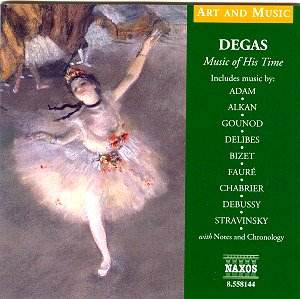Another interesting concept from Naxos making
excellent use of material taken from their ever-growing catalogue.
The visual arts and music have always proceeded side-by-side,
one borrowing from or being inspired by the other. This new compilation
is of music that was by composers contemporaneous with the French
Impressionist painter and sculptor, Edgar Degas (1834-1917). Most
of the above standard repertory works will be familiar and needs
no comment other than that they are all creditably performed –
the Debussy piano solos by Thiollier being especially lucid and
expressive. Perhaps the least known music will be the piano pieces
by Alkan. Pianists normally associate particularly dense, difficult
material with Alkan but the little pieces in this compilation
are, for the most part, comparatively simple and dreamily romantic,
except the quicksilver Esquisse ‘Fantaisie’. They are played with
elegance and refinement by Martin.
Just as important as the music on this album
are the brilliant, erudite notes by Hugh Griffiths. These are
spread over all but six pages of its lavish well-illustrated 24-page
booklet. By nature, Degas appears to have been a brilliant conversationalist
and something of a wit but friends were often wary of his sharp
tongue. He was something of an intellectual and a critic, his
background privileged for his father ran the Paris branch of a
Naples bank and his mother had interests in a New Orleans cotton
business. There was no parental opposition to Degas’s artistic
aspirations which were profitable: his dance pictures found a
ready market. Thanks to highly placed contacts Degas was able
to move freely behind the scenes at the Opéra and he had
many friends amongst the orchestra. Clearly he had a fondness
for the ballet and opera. The ballet dancer who danced Giselle
in the first production of the ballet was the lover of the choreographer
Jules Perrot who, later, as an old man, would be the dancing master
in Degas’s most famous scenes of the ballet class.
Degas’s tastes were fairly conservative. He liked
Weber, Verdi, and Gounod. Faust was his favourite opera
and Delibes’ Coppélia never lost its appeal for
him. Bizet had been friendly with him when they were both resident
at the Villa Medici in Rome. And when he was almost blind, Degas
attended the first season of the Ballets Russes in 1909.
The booklet also contains a short essay on Degas’s
sculptures concentrating, of course, on his exquisite Little
Fourteen-year-old Dancer. There is also a four-page life-line
that not only covers the major events in Degas’s life but also
the events that shaped the period and some details of the lives
of his contemporary artists and musicians.
Excellent informative notes on Degas and music
plus ballet and theatre pictures and sculptures. Quality musical
excerpts from works by French contemporary composers make this
an alluring compilation.
Ian Lace
Bill Kenny has also listened to this disc
The brochure by Hugh Griffith included with this
disc, describes the Parisian society of Degas’s adult lifetime
(from the 1850s onward) extremely vividly. By 1867, the year of
the Universal Exhibition, we learn that Paris had been largely
rebuilt to provide ‘wide boulevards, and spacious, unobstructed
views, giving free play to light and air.’ We learn too that Edgar
Degas became a typical flâneur, an ‘idle and well-dressed
stroller, who cast his sharp eye everywhere around him like a
detective, piecing together the visible clues of other people’s
lives.’ As a privileged and well-to-do young man Degas could take
full advantage of the flourishing life of public entertainment
to be found in the city, including the theatres, cafés-concerts,
vaudevilles and music halls which might attract as many as 54,000
people on a ‘good night.’
Like Griffith’s excellent brochure included with
the Raphael CD in Naxos’ Art and Music series (reviewed
elsewhere) this one provides a clear and informative pen-picture
of the artist’s environment and a biography that explains the
content of his major works to a significant degree. Importantly
too, Griffith relates Degas’s life very carefully to the musical
life of 19th century Paris including his personal relationships
with many of the important musicians of his time. It is all very
well done and includes both a chronology of the musical events
coinciding with the completion of some of the artist’s work and
six illustrative full-colour photographs.
The music on this disc has been chosen essentially
because it is either typical of works that Degas would have enjoyed
or because he had some kind of personal relationship with the
composers. Naturally enough, given the content of the best known
of the artist’s paintings and sculptures a good deal of it is
well known ballet music (Adam, Gounod, Delibes, Stravinsky) but
there is also other orchestral music (Bizet, Chabrier) and piano
music by Alkan, Fauré and Debussy.) The performances are
always competent with orchestras and performers from the typical
Naxos stable, and the recording quality is fine.
As I thought about the market for this particular
disc however, and compared it with the Raphael disc in the same
series, it occurred to me that there is a distinct difference
between them. Almost all the music on this disc is decidedly ‘popular’
whereas the ‘Raphael’ music is more specialized and could be unfamiliar
even to some established music lovers. I found the Degas brochure
fascinating but I’m not sure I’d listen to the music much. I could
buy it for ‘arty’ friends, of course.
Bill Kenny

